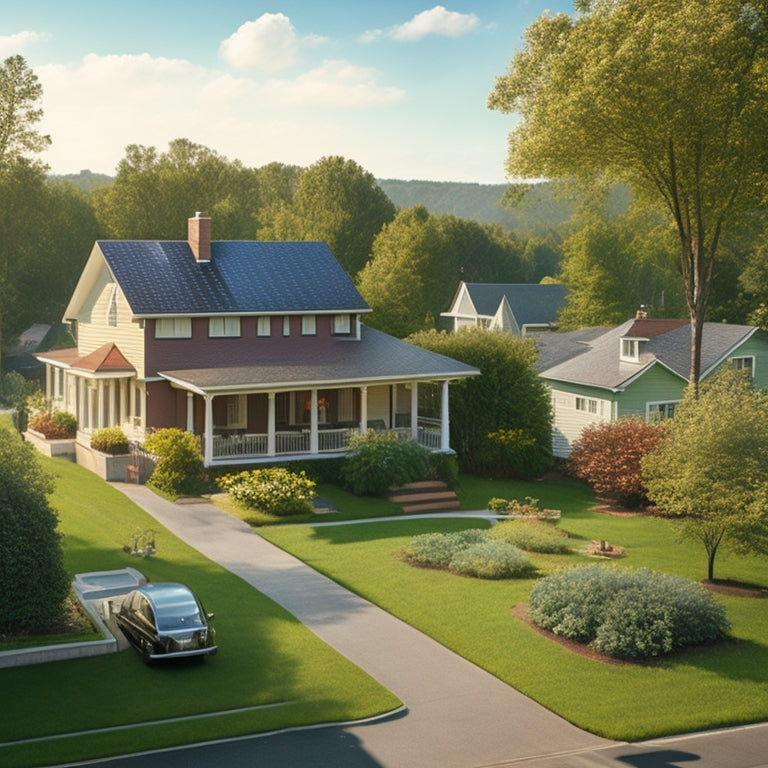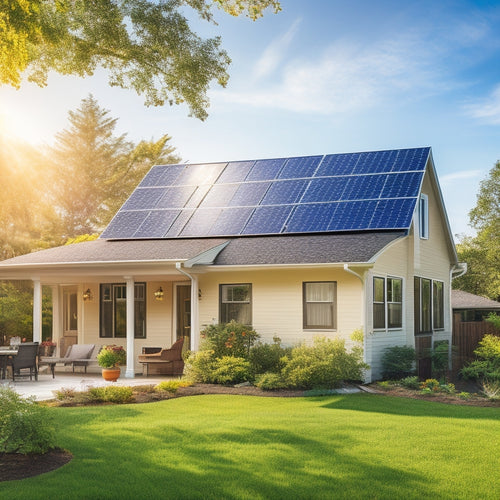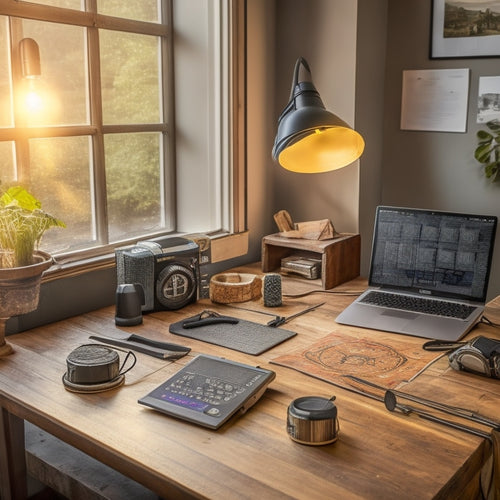
What to Consider Before Installing Solar Panels for Your Home
Share
As you consider installing solar panels for your home, you'll want to assess your home's solar potential by evaluating sunlight exposure, shading, and roof orientation. You'll also need to understand the true costs of ownership, including system purchase price, financing options, and ongoing maintenance costs. Additionally, choosing the right solar provider, evaluating energy efficiency opportunities, traversing local regulations and permits, and considering battery storage options are vital steps to guarantee a successful installation. By carefully assessing these factors, you'll be well on your way to utilizing the power of the sun, and exploring further will reveal even more possibilities for maximizing your solar investment.
Key Takeaways
- Assess your home's solar potential by evaluating sunlight exposure, shading, roof orientation, and local building codes.
- Understand the total system purchase price, financing options, tax incentives, and ongoing maintenance costs of solar panels.
- Choose a reputable solar provider based on service guarantees, installation timeline, financing options, and customer reviews.
- Evaluate energy efficiency opportunities by assessing current energy use, identifying energy-wasting areas, and optimizing home insulation.
- Research and comply with local regulations, permits, and environmental impact considerations before installing solar panels.
Assessing Your Home's Solar Potential
Most homes receive enough sunlight to generate a substantial amount of electricity, but the amount varies considerably depending on several factors. To accurately assess your home's solar potential, you'll need to evaluate the amount of sunlight your roof receives.
A shading analysis will help identify any obstructions, such as trees or neighboring buildings, that could reduce energy production. You'll also need to examine your roof's orientation, as a south-facing roof receives the most sunlight.
East- and west-facing roofs receive about 75% of the sun's energy, while north-facing roofs receive the least. The pitch of your roof is also important, as a steeper pitch can accommodate more panels.
Additionally, local building codes and regulations may impact the size and placement of your solar panel system. By taking these factors into account, you can determine the ideal size and configuration of your solar panel system to maximize energy production.
A thorough assessment will help you make informed decisions about your solar installation, ensuring you get the most out of your investment.
Understanding Solar Panel Costs
When considering solar panels for your home, you'll need to factor in the system purchase price, which includes the cost of the panels, inverters, mounting hardware, and installation.
You'll also want to think about ongoing maintenance costs, such as cleaning and inspecting the system, replacing inverters, and repairing or replacing damaged panels.
System Purchase Price
Reflecting on the overall investment, the system purchase price is a critical factor in determining the viability of solar energy for your home.
You'll need to evaluate the upfront cost of the solar panel system, including the panels, inverters, mounting hardware, and installation fees. The total system purchase price can range from $15,000 to $30,000 or more, depending on the system size and quality.
To make solar energy more affordable, you can investigate financing options, such as loans or power purchase agreements (PPAs). These financing options can help you spread the cost over time, making it more manageable.
Additionally, you may be eligible for tax incentives, such as the Solar Investment Tax Credit (ITC), which can help reduce your tax liability. Currently, the ITC allows you to claim 26% of the total system purchase price as a tax credit.
Ongoing Maintenance Costs
Monitoring your solar panel system's performance is crucial for ensuring it operates at its maximum potential, and this involves incurring ongoing maintenance costs.
You'll need to take into account the frequency of cleaning your solar panels, as dirt and debris can reduce their efficiency. The recommended cleaning frequency varies depending on your location, but it's typically every 6-12 months. You can either clean the panels yourself or hire a professional, which may cost around $100-$300 per cleaning.
Additionally, you should review your warranty coverage to understand what's included regarding maintenance and repairs. Most manufacturers offer a 25-year warranty, but it's vital to understand the terms and conditions.
You may need to perform routine checks and maintenance tasks to keep your warranty valid. Be sure to factor in the cost of any necessary repairs or replacements, which can range from $100 to $1,000 or more, depending on the issue.
Choosing the Right Solar Provider
As you venture into the world of solar energy, selecting a reputable solar provider is vital to secure a successful installation that meets your energy needs and budget. You want a provider with a solid reputation, backed by service guarantees and a proven track record of timely installations.
Be sure to ask about their installation timeline, as well as the financing options they offer to fit your budget. Research customer reviews to get a sense of the provider's level of customer satisfaction.
It's also important to review the warranty coverage offered by the provider, including the length of the warranty and what's covered. Look for a provider with local knowledge, as they'll be more familiar with local building codes and regulations.
Review their project portfolio to see examples of previous installations and the types of systems they've installed. By considering these factors, you can confidently choose a solar provider that meets your needs and guarantees a successful installation.
Evaluating Energy Efficiency Opportunities
You'll want to assess your current energy use to understand where you can cut back and make the most of your solar panels.
Identifying energy-wasting areas, such as inefficient appliances or lighting, will help you prioritize areas for improvement.
Assess Current Energy Use
Before installing solar panels, it's essential to understand your current energy usage to identify areas of inefficiency. This assessment will help you determine how much energy you need to generate and when you need it most.
Take a close look at your past utility bills to understand your energy consumption habits, including peak usage times. Are you using more energy in the morning when you're getting ready for work, or in the evening when you're cooking dinner? Identifying these patterns will help you optimize your solar panel system's performance.
You may also want to think about conducting an energy audit to pinpoint areas in your home where energy is being wasted. This will help you prioritize energy-efficient upgrades, ensuring your solar panels provide the maximum benefit.
Identify Energy-Wasting Areas
Now that you have a clear understanding of your energy consumption habits, it's time to identify areas in your home where energy is being wasted. This step is essential in evaluating energy efficiency opportunities that can help you maximize the benefits of your future solar panel installation.
Conducting an energy audit is a great way to pinpoint areas of inefficiency. This thorough examination of your home's energy usage can reveal hidden energy-wasting culprits such as outdated appliances, inefficient lighting, and air leaks. By identifying these areas, you can prioritize upgrades and repairs to optimize your energy usage.
For instance, upgrading to energy-efficient appliances and installing smart power strips can greatly reduce standby power consumption. Additionally, consider insulation upgrades to reduce heat loss during winter and heat gain during summer.
Optimize Home Insulation
About 30% of a home's heated air escapes through its ceilings, walls, and floors, making insulation a critical component of energy efficiency.
You'll want to verify your home is well-insulated to maximize the benefits of your future solar panel installation. Start by identifying areas that need improvement. Check for gaps and cracks in your walls, ceilings, and floors, and consider adding insulation to your attic, walls, or floors.
Insulation upgrades can be as simple as adding fiberglass batts or as complex as installing spray foam insulation.
When selecting insulation materials, consider factors like R-value, durability, and environmental impact. You'll want to choose materials that provide ideal energy efficiency without breaking the bank.
Remember, a well-insulated home will reduce your energy consumption, allowing your solar panels to generate more power and saving you money on your utility bills.
Navigating Local Regulations and Permits
Your local government's permitting process is like a gateway to utilizing the sun's energy, and guiding through it requires careful attention to detail. Before installing solar panels, you'll need to verify compliance with local regulations and obtain necessary permits. This involves reviewing zoning laws, permit requirements, and installation guidelines specific to your area.
You'll also want to investigate local incentives that may offset the cost of your solar panel system. Additionally, you'll need to comply with utility regulations, environmental regulations, and any rules set by your homeowner association, if applicable.
During the installation process, you'll undergo inspection processes to verify your system meets safety and performance standards. It's crucial to work with a reputable installer who's familiar with local regulations and can assist you through the permitting process.
Considering Battery Storage Options
As you prepare to capture the sun's energy, an important factor is how to store the excess power your solar panel system generates during the day for use during the night or on cloudy days.
Battery storage options can provide energy independence and guarantee your home remains powered during outages. You'll need to reflect on various battery types, such as lead-acid, lithium-ion, and saltwater batteries, each with its own advantages and disadvantages.
When evaluating installation options, think about whether you want a grid-connected system, which allows you to sell excess energy back to the grid, or an off-grid system, which provides complete independence from the grid.
Load management is another vital aspect, as you'll need to manage energy distribution to optimize system performance and prolong system longevity.
Performance monitoring is also essential to track your energy production and consumption.
Finally, contemplate the environmental impact of your battery choice, as some options have a lower carbon footprint than others.
Frequently Asked Questions
Can I Install Solar Panels on My Roof if It's Shaded?
You'll want to assess the shading impact on your roof before installing solar panels, considering roof orientation and obstructions like trees or buildings that may reduce energy output, even if it's only partial shading.
How Long Does It Take to Install Solar Panels on a Home?
You'll typically spend 1-3 days waiting for permits, 1-2 weeks on the installation process, and 1-2 months for inspections and utility activation, making the total installation timeline around 3-5 months from start to finish.
Do Solar Panels Work During Power Outages?
You'll find that solar panels alone don't provide power during outages, but with battery storage, you can achieve grid independence, ensuring a steady supply of electricity even when the grid goes down.
Can I Install Solar Panels on a Metal Roof?
"When in Rome, do as the Romans do" - and if you have a metal roof, you're in luck! You can install solar panels on it, leveraging metal roof advantages like durability and water-tightness, but consider specialized installation requirements and potential additional costs.
Will Solar Panels Increase My Home's Value?
You'll likely increase your home's value by installing solar panels, as they enhance energy efficiency, potentially reducing property taxes through exemptions or deductions, making your property more attractive to potential buyers.
Conclusion
As you stand on the cusp of utilizing the sun's energy, remember that installing solar panels is an expedition, not a destination. You've weighed the pros and cons, assessed your home's potential, and charted the intricacies. Now, it's time to take the leap and reveal the power of the sun. With the right provider, permits, and battery storage, your home will shine like a guiding light of sustainability, illuminating a brighter future for generations to come.
Related Posts
-

How to Finance Home Solar Panels
Financing home solar panels offers several strategies to lighten your initial costs while maximizing long-term benefi...
-

Solar Inverter Troubleshooting for Beginners
Troubleshooting your solar inverter starts with understanding its efficiency and performance metrics. Check for prope...
-

How to Reduce Home Energy Bills
To reduce your home energy bills, start by investing in energy-efficient appliances and upgrading your insulation. Lo...


